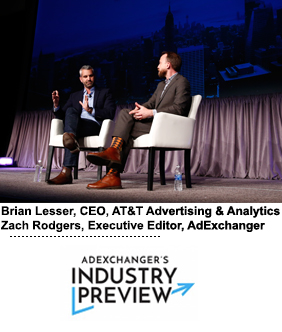 With Time Warner on board or not, AT&T is pushing forward with its vision for the next potential addressable ad platform giant.
With Time Warner on board or not, AT&T is pushing forward with its vision for the next potential addressable ad platform giant.
CMOs or holding company agencies might pour money into Google and Facebook, but “they’re nervous about the content they’ve produced living in environments they can’t control,” said Brian Lesser, AT&T’s CEO of advertising and analytics, at AdExchanger’s Industry Preview in New York City on Thursday.
AT&T’s pitch is addressability – based on AT&T’s mobile carrier customer data and DirecTV subscriber data – and inventory that, unlike YouTube or Facebook video, matches the high-quality sheen of television production.
“The brand-safety issue for Facebook and Google will get worse before it gets better,” Lesser predicted.
AT&T will consider expanding its ad tech beyond its own media, as ad platforms like Google, Facebook and Amazon have done, he said. But “our first priority is our owned and operated media.”
AT&T’s vision of its biddable media, with content and creative production more like television, means its network properties – the potential Time Warner content in particular – could be the only viable digital or OTT channels to which the AT&T ad platform connects for the foreseeable future.
But that’s part of the new AT&T’s sell to customers.
“Consumers don’t want to be bludgeoned to death with performance advertising,”
Lesser said. “What better canvas to fix that than a marketplace that’s only professionally produced content.”
Tough challenges remain, however.
AT&T is planning a three-legged ad platform – built on data, distribution and content. But it still hasn’t secured the content leg.
AT&T’s proposed acquisition of Time Warner, which is being challenged by the US Justice Department on antitrust grounds, “is of paramount importance in terms of building the platform,” he said.
But Lesser isn’t waiting on Time Warner’s film and TV assets to make his case to the buy side and sell side.
Google and Facebook have been powerful tech innovators, he said, but they offer “an abstracted view of readers and customers.”
AT&T will anonymize subscriber identities in its first-party data set, the same as all other major platforms, but will return insights to buyers and sellers by connecting their audiences to its TV consumption data and mobile in-app activity and web browsing, he said. “Publishers can actually understand their readers and advertisers leave smarter.”
Lesser, the former CEO of GroupM North America, is well-acquainted with the problems major brands and media agencies have in the data-driven marketplace. For instance, many data and ad tech vendors add to a campaign, he said, but taken as a whole, digital intermediaries are keeping too many media dollars from going to media.
“We think there’s an opportunity to compress that,” he said.
This post was syndicated from Ad Exchanger.

More Stories
Ticker: Chris Cuomo to Moderate NewsNation Town Hall Marking Trump’s 1st 100 Days
Casie Mason Joins WFIE in Evansville as AM Anchor
Here’s How Various News Outlets Will Cover Pope Francis’ Funeral